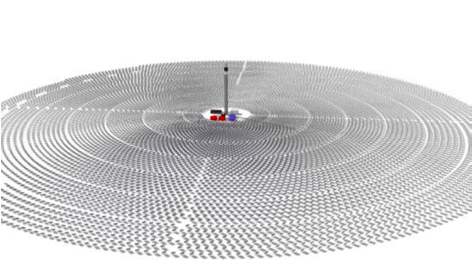Spanish renewable energy giant Abengoa is hopeful of convincing a major iron ore mine operator in Western Australia to sign a contract to buy electricity to support the groundbreaking 20MW solar tower with storage plant it is proposing for the state’s mid-west region.
Abengoa, in May, revealed it had received funding from the Australian Renewable Energy Agency to conduct a feasibility study into what could be Australia’s first large-scale solar power tower with storage facility.
 It will likely be located at Perenjori, a small village about 350km north of Perth, on the edge of Western Australia’s main grid and near a booming mining region.
It will likely be located at Perenjori, a small village about 350km north of Perth, on the edge of Western Australia’s main grid and near a booming mining region.
Abengoa’s Australia business manager, James Harding, revealed on Wednesday that the plant was likely to have six hours of molten salt storage, which would enable dispatchability, though probably not 24/7 output. He said he was hopeful of signing a power purchase agreement with a nearby iron ore miner, who was interested in such technologies to offset the soaring cost of diesel.
Concentrated solar thermal power (CSP) with storage is considered to be the next big breakthrough for renewables, given that it can deliver dispatchable energy at scale, and, according to Abengoa and others, will be able to do so at the same cost of baseload gas by as early as 2020.
“What we want to do is to demonstrate that CSP (concentrating solar thermal) is a dispatchable technology, and that it can capture maximum value for the network,” Harding said.
Harding says 20MW is on the small side of an optimal plant size, but a good minimum capacity to demonstrate the ability of the technology in Australia – Abengoa is already building, or has built plants in South America, the US, the Middle East, Africa and Europe.
He notes that the 110MW plant planned for Chile’s Atacama desert will be built without subsidy – a reflection of the excellent solar resources and the high cost of electricity in that country.
In Australia, the most likely market is for miners, who are paying extraordinarily high costs for diesel or gas. Harding says there is growing interest from this sector in solar technologies, particularly with storage. Rio Tinto has signed a deal for solar PV plus storage, and rival technology player Solar Reserve is also looking at the same market.
The idea of a small demonstration plant is to create a pathway for cost reductions in future plant. Some of these will come from economies of sale, and much of it from building local supply chains and operational earnings.
The power tower where a receiver collects the heat from thousands of heliostats (mirrors) will be 150m tall. Abengoa is currently considering whether to use its own 140 square metre mirrors, or a small 5 square metre design developed by Australia’s CSIRO.
Large molten salt storage tanks with temperatures of up to 565°C. The plant will have an annual output of around 100GWh a year.
Local developers WestGen and National Power will also have a role in the project.
Harding said the local council was very supportive. Being located at the edge of the state’s main grid also provided an opportunity to demonstrate the benefits of delivering dispatchable energy into a market with a big demand for high value peak and shoulder electricity. “There is an excellent prospect for a further rollout of solar thermal power,” Harding said.
The feasibility study will be completed by the end of the year, but the project may depend on future policies and the retention of ARENA as a standalone institution, with funds available to be deployed for such first-of-their-kind technologies.








